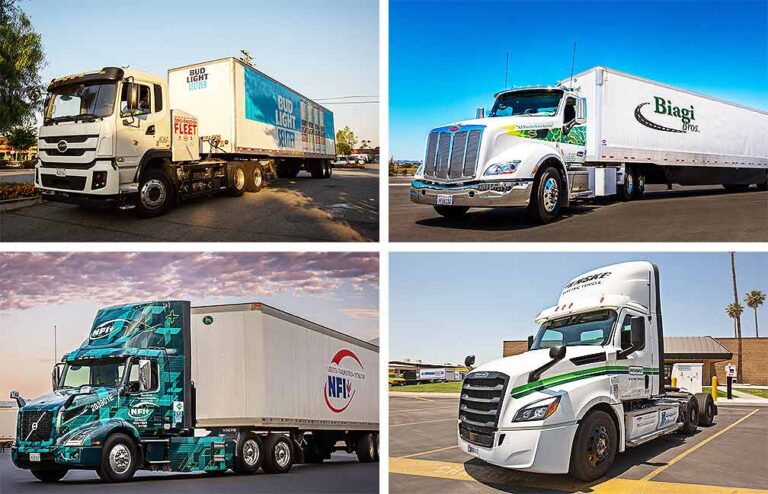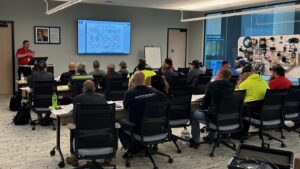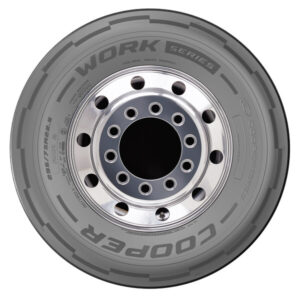FORT WAYNE, Indiana — The North American Council for Freight Efficiency (NACFE) released Thursday the third of four market segment reports — Electric Trucks Have Arrived: The Use Case For Heavy-Duty Regional Haul Tractors — based on findings from last year’s Run on Less – Electric (RoL-E) freight efficiency demonstration.
The top level finding from the report is that 50% of this Class 8 market segment is ready for electrification now.
“Heavy-duty Class 8 tractors are the most challenging of all the truck segments considered for electrification,” Rick Mihelic, lead author and director of emerging technologies at NACFE, said. “Battery electric vehicles cannot replace all diesels, but they can replace a significant share of regional-haul ones, where the driver and truck return to base each day, where loads are usually cubed out, or in the case of beverage deliveries, the daily distances are not very long.”
Four fleet-OEM pairs in RoL-E operated heavy-duty, regional-haul tractors: Anheuser-Busch with a BYD 8TT tractor; Biagi Bros. with a Peterbilt Model 579EV; NFI with a Volvo VNR Electric; and Penske with a Freightliner eCascadia.
As Run on Less – Electric concluded in September 2021, NACFE predicted that 70% of this market segment was electrifiable.
Given the more detailed analysis, interviews with industry experts and further research for this report, we now consider this market segment to be 50% electrifiable with lower average daily miles, which results in the avoidance of nearly 29.4 million metric tons of CO2e annually (e equals carbon dioxide equivalent).
NACFE estimates the entire CO2e to be eliminated by this segment at an average of 250 miles per day to be 97.8 million metric tons.
“Peterbilt’s strategy is to identify those niches where the technology is most ready and the financial benefits for our customers are there and build our way up from that point,” Matt Wetta, national accounts manager of EV at Peterbilt, said.
The Trucker News Staff produces engaging content for not only TheTrucker.com, but also The Trucker Newspaper, which has been serving the trucking industry for more than 30 years. With a focus on drivers, the Trucker News Staff aims to provide relevant, objective content pertaining to the trucking segment of the transportation industry. The Trucker News Staff is based in Little Rock, Arkansas.









Daycabs or regional drivers who are home every day can make traffic a lot less congested if they stay away from middle lane and stay with those 63 mph trucks in the right lane.
Every time we see a back up it’s a day cab who is holding traffic up
About electric trucks yea the USA is not ready for it if it was give police fire department ambulance and wreckers a eletruck first see how well it goes.
I have in Texas 3 Tesla drivers in my street if they are loading there cars even with 302 of them wit(solar panels on roof we can’t use laundry or ac so yea America is not ready yet
That makes no sense at all. If a daycab is the problem holding up traffic like you say, and I’m going to assume going 63 mph, then what makes you think that all of them going 63 mph in the right hand lane is going to work with traffic needing to merge on and merge off the interstates? The best way to combat the congestion is to either have roads only for trucks and the same for cars when around major cities, or for trucks in Hi traffic areas only run when congestion is at a minimum. Not when rush hour is going on. I myself try to avoid any rush hour at any major city when I’m out as to not add to congestion.
I see that the editorial board at the Trucker has become woke and a worshipper at the altar of the green energy gods. Guys and gals, the Trucker is showing its soul when they become slaves to a battery and the poorly thought out concept of electrification. How long before they realize that China has control of a majority of the lithium needed and that it is not as plentiful or green as they thought.
I love reading these letters to US Truckers, it’s like one of those scam emails you get in your junk mailbox and you select the box delete all. The technology for electrifying trucks maybe arising but nothing to worry about. By the year 2100 sounds more realistic